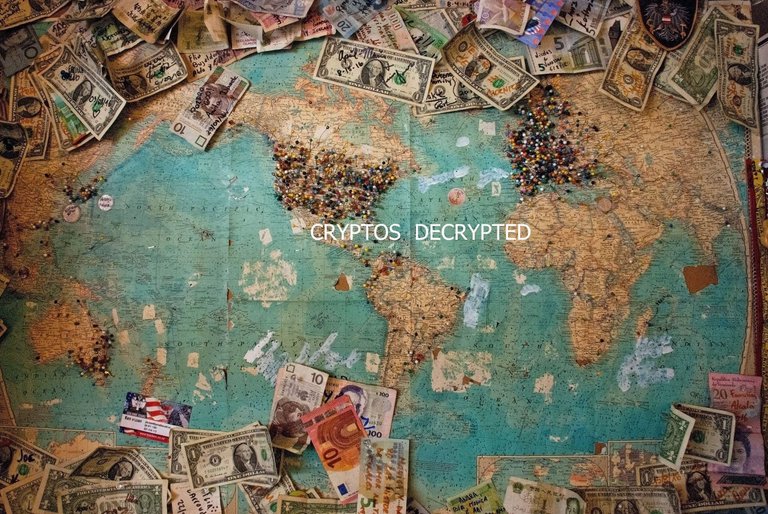
Please click the link below to listen to the 77th episode of my weekly crypto podcast ‘Two Minute Crypto.’ These are intended to be short, single-topic ramblings on some aspect of the cryptosphere. Comments and critiques welcome.
External Podcast Link
https://anchor.fm/the-two-minute-crypto-podcast/episodes/Two-Minute-Crypto--Key-Concepts-15---Explaining-the-Relationship-between-Fiat-Paper-Money-and-Central-Banks-edd39t
Transcript
Key Concepts 15 - Explaining the Relationship between Fiat (Paper Money) and Central Banks
Welcome to Two Minute Crypto – this week we delve into fiat and the role central banks play in its creation.
First a simple disclaimer: This series is aimed at providing crypto enthusiasts with a go-to source to outline ideas that are essential to engaging with the crypto landscape. Hopefully, each episode should be understandable by any reasonably open-minded individual with little or no prior knowledge of the subject matter. In paring things down to the bone many generalizations will be made. As a long-time member of the crypto community, you may find some of the descriptive language employed far too broad or too loosely applied. However, the goal of this series is to open the door to engagement where the real process of learning and understanding can begin.
As any crypto enthusiast will happily inform you – fiat is backed by nothing but trust. All global currencies are simply localized state-recognized legal tender. This wasn’t always the case – prior to World War 1 – most currencies were backed by gold bullion. At least notionally, it was possible to redeem paper money for the gold behind it. By 1971 only the US retained a partial peg to gold until, it too, dropped the gold standard. It was promoted as a temporary measure but remains in place today. Since then the world has seen an unprecedented expansion in the global money supply.
How then do governments attain this ever-increasing supply of money? Well, by a somewhat clever sleight of hand. Generally, governments themselves do not directly inflate the money supply. For that, they depend on independent and semi-private central banks. It is these bodies that issue new currency.
Governments issue bonds of various terms as securities to cover debt which private entities such as banks, corporations, wealthy individuals, and other nations buy in return for an interest payment of some form. These securities may, in turn, be used to access funds from the central bank. The central bank is the body actually creating new money and it uses those funds to facilitate credit expansion by banks and government spending through holding government-issued debt. Sometimes the Central Bank buys treasury bonds directly from the government. In other cases, it acquires them through banks and other large market players. The end result though is an inflated monetary supply where year by year the number of dollars, for example, increases, thereby inexorably reducing the purchasing power of each individual dollar.
Of course, governments raise funds through taxation but it is the repackaging of debt as securities that allow continual credit expansion. This expansion is entirely dependent on central bank support.
The cycle runs like this -the government wishes to expand its spending – it issues debt in the form of bonds (bills/notes – not to be confused with actual fiat bills)) those bonds are bought by third parties who in turn use those bonds as collateral with the central bank in order to access the money they issue. The Central Bank simply creates an entry on an electronic ledger in order to purchase such securities and just like that more money has entered the system. Actual physical currency makes up only a tiny fraction of the total supply – in most developed economies less than 3% – the rest is digital.
Fiat has no limit, its value being entirely derived from a broad-based acceptance that it can be reliably used to purchase goods and services. Inbuilt in this system is the inevitable and purposeful erosion of the purchasing power of each individual unit of fiat – the goal is credit expansion not purchasing power preservation.
Despite the gold standard being long dead – many people around the globe continue to believe that their individual currencies are backed by gold or other government assets. This is simply not the case.
The consequences of unlimited access to money are many and profound – not the least of which is an ever-increasing debt burden on the population as more and more state funds are siphoned away to pay interest on the debt (securities) held by third parties.
Bitcoin’s coded rate of creation, declining issuance, and capped total supply differ fundamentally from the fiat model. This is the core value proposition of BTC as ‘hard money’ – there is no workaround – no means of creating more BTC to finance debt.
Thanks for listening.


Good to see you back on blessing us with your content CD.
Posted Using LeoFinance